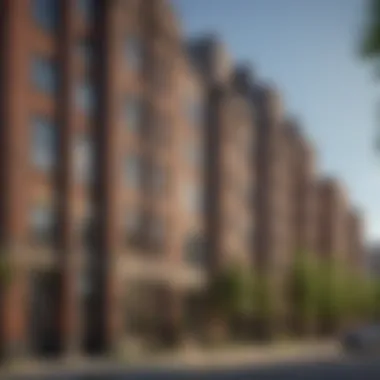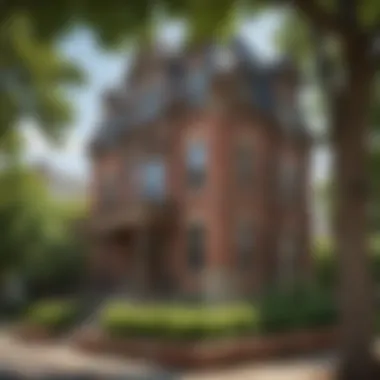Discovering Cathedral Heights: A Unique D.C. Neighborhood


Intro
Cathedral Heights is a neighborhood of notable charm in Washington D.C. Often overlooked, it encompasses a blend of architectural styles and community vibrancy. This area is not only residential but also important for its historical context. With its proximity to the National Cathedral and various amenities, it serves as a microcosm of D.C.'s rich tapestry.
Focusing on the unique attributes of Cathedral Heights, this article aims to provide a comprehensive overview for real estate enthusiasts, travel lovers, and interior design aficionados. We will explore featured homes that exemplify the neighborhood’s unique architectural characteristics, incredible locations that highlight both cultural and geographic significance, and insights into lifestyle elements that define living in Cathedral Heights.
Featured Homes
Architectural Styles
The architectural landscape of Cathedral Heights is captivating. A stroll through its streets showcases a diverse array of styles. From the classic Tudor homes to modern developments, the neighborhood reflects its evolution over the decades.
- Tudor Revival: Characterized by steeply pitched gable roofs and decorative half-timbering. Homes built in this style are particularly striking and add to the historical flavor of the area.
- Mid-Century Modern: This style emphasizes simplicity and functionality. Many houses from the mid-20th century feature open floor plans and large windows, offering abundant natural light.
- Contemporary Designs: Newer constructions often incorporate eco-friendly materials and smart home technologies, appealing to today’s buyers.
Unique Design Elements
Homes in Cathedral Heights often have features that reflect artistic flair and practical design. Some noteworthy aspects include:
- Landscaped Gardens: Many properties have well-kept gardens that enhance their curb appeal.
- Custom Interiors: From exposed brick to intricate moldings, the interior design elements add character and warmth.
- Historic Detail: Original fixtures and restoration efforts allow for a blend of modern living with Old World charm.
"The architectural diversity of Cathedral Heights is a testament to the creativity and cultural evolution of Washington D.C."
Incredible Locations
Geographic Highlights
Cathedral Heights is positioned strategically in the northwest quadrant of Washington D.C. It offers scenic views and access to green spaces that enhance its residential appeal. Nearby parks, like Glover Archbold Park, provide ample opportunities for outdoor activities. The neighborhood is also close to several major thoroughfares, making commutes manageable for residents.
Cultural Significance
The proximity to the Washington National Cathedral elevates Cathedral Heights' cultural significance. This iconic structure serves not only as a religious site but also as a gathering place for community events. Residents have the opportunity to participate in various cultural activities that connect them to the city’s rich history. Additionally, the neighborhood is situated near cultural hubs such as the aforementioned Glover Archbold Park and other community amenities, like schools and shops, fostering a sense of belonging.
Overall, Cathedral Heights presents a unique blend of architecture, geography, and community lifestyle. This neighborhood, often regarded as one of D.C.'s hidden gems, holds great appeal for diverse groups, including prospective homebuyers and travelers.
Overview of Cathedral Heights
Cathedral Heights is a distinctive neighborhood located in the northwest quadrant of Washington D.C. Its unique blend of historical significance, architectural diversity, and community engagement makes it a compelling subject for exploration. This section provides a foundational understanding of Cathedral Heights, setting the stage for the deeper analysis in subsequent sections.
The importance of examining Cathedral Heights lies not only in its physical attributes but also in its demographic characteristics and community dynamics. The area is well-known for its scenic streets, proximity to significant landmarks, and a strong sense of community. Residents often enjoy an array of amenities including parks, shops, and cultural institutions, showcasing what makes this location appealing to both current inhabitants and potential newcomers.
Geographical Context
Geographically, Cathedral Heights is bordered by the National Cathedral to the north and the picturesque grounds of Glover Archbold Park to the west. The neighborhood’s elevation offers striking views of the surrounding cityscape, enhancing its appeal.
This area is characterized by tree-lined streets and a mix of residential architecture, primarily single-family homes and townhouses. The accessibility to main thoroughfares provides convenient travel routes to other parts of Washington D.C., contributing to its desirability as a residential area. The rich green spaces also offer an attractive environment for outdoor activities.
Demographics and Community Profile
In terms of demographics, Cathedral Heights showcases a diverse community. The population is made up of families, professionals, and students, contributing to a vibrant social fabric. According to recent data, the area has seen a steady increase in residents, reflecting its growing popularity.
Community engagement plays a significant role in Cathedral Heights. The presence of neighborhood associations promotes a sense of belonging among residents. Various events and initiatives foster connection, from local festivals to volunteer opportunities.
Overall, understanding the community profile and geographical context of Cathedral Heights is essential for appreciating its uniqueness. These factors collectively contribute to the overall character of the neighborhood, making it an attractive destination for various demographic groups.
"The charm of Cathedral Heights lies in its uniqueness, from its stunning architecture to its connected community."
This section aims to provide a comprehensive overview, equipping the reader with essential insights as we move forward into Cathedral Heights' rich historical background.
Historical Background
Understanding the historical background of Cathedral Heights provides crucial context for comprehending its modern day character and appeal. This neighborhood in Washington D.C. is not just defined by its real estate and architecture; it reflects a legacy that shaped its community profile and cultural essence. Historical events, development patterns, and architectural milestones contribute to the neighborhood's unique identity, making this exploration of its past vital for those interested in its present offerings and future outlook.
Early Development
Cathedral Heights began to take shape in the early 20th century. Its location near the prominent Washington National Cathedral established the area as a significant cultural and religious hub. By the 1920s, the city planned for residential developments that would attract a middle and upper-middle-class population. One remarkable aspect of early development was the focus on incorporating green spaces and parks. These planning ideals directly responded to a growing desire for urban dwellings that provided not only comfort but also an escape into nature. This careful strategic planning laid foundation for what would later evolve into a neighborhood known for its attractive residential settings and community spirit.
The architectural designs of this era varied, showcasing influences from different styles and movements prevalent during the 20th century, such as Colonial Revival and Mediterranean aesthetics. As homes sprung up, they featured ample yards and porches, further enhancing the neighborhood's inviting atmosphere. Developers paid attention to creating a harmonious blend of buildings that complemented the landscape rather than concealed it.


Significant Historical Events
Several key historical events in Cathedral Heights defined its trajectory and social fabric. One notable event was the completion of the Washington National Cathedral in 1990. This iconic structure not only draws tourists but has also cemented Cathedral Heights' status as a prominent part of the cityscape. Its architectural grandeur and historical importance serve to enrich the neighborhood's character.
Moreover, the neighborhood has witnessed various community-driven initiatives, particularly in the latter half of the 20th century. Local residents frequently organized efforts to preserve the historical and cultural elements of the area. These initiatives included advocating against unchecked urban development that threatened to alter the neighborhood's distinctive charm.
Community events, such as historical tours and local markets, have increasingly gained popularity, fostering community engagement.
In the 21st century, Cathedral Heights has continued to evolve. It balances new developments with the preservation of its historical essence. This blend speaks volumes about how this neighborhood has adapted while honoring its past.
Architectural Highlights
Understanding the architectural landscape of Cathedral Heights is imperative to appreciating its unique character. This area showcases a variety of residential styles and notable buildings that contribute significantly to the neighborhood's identity. The architectural highlights not only reflect the historical context but also demonstrate the evolving preferences of its residents. These elements are essential for anyone interested in the character of Washington D.C. and its residential spaces.
Residential Styles
Single-Family Homes
Single-family homes in Cathedral Heights are often marked by distinct architectural styles. This housing type offers considerable privacy and space, making it an attractive option for families. The appeal lies in the personal outdoor areas some of these homes provide, such as gardens or yards. Single-family homes frequently feature colonial and contemporary designs, which add charm to the streetscape. One advantage is the opportunity for customization, allowing residents to create a unique living environment.
Condos and Apartments
Condos and apartments serve those who prefer more compact living arrangements. These units tend to emphasize modern designs and conveniences. Many of them offer amenities such as pools, gyms, and communal spaces. This makes them attractive for young professionals or those looking to downsize. However, the drawback can be the lack of personal outdoor space compared to single-family homes. The accessibility and reduced maintenance responsibilities often tilt the preferences towards these types of residences.
Townhouses
Townhouses in Cathedral Heights provide a hybrid option between single-family homes and condos. They often boast a multi-level design that maximizes space while offering a sense of community. The row house style is prominent here, providing a more urban feel but with personal touches. Given their strategic layouts, townhouses offer a mix of privacy and community engagement. Nevertheless, residents may face challenges with limited outdoor space as compared to free-standing homes.
Notable Buildings
Washington National Cathedral
The Washington National Cathedral is an iconic landmark within Cathedral Heights. This stunning architectural achievement features Gothic revival style, characterized by intricate stained-glass windows and remarkable stone carvings. Its presence enriches the local culture and draws visitors, making it a vital part of the community's identity. The cathedral serves not only as a worship site but also as a venue for concerts and special events, adding dimension to the area's cultural life.
Local Churches and Religious Sites
Apart from the Washington National Cathedral, Cathedral Heights is home to various local churches and religious sites that reflect the community’s diverse spiritual life. These buildings often feature unique designs and contribute to the neighborhood's historical texture. Many of them actively participate in community activities, enhancing local engagement and unity. This aspect of the area supports the notion that architecture is not solely about aesthetics but encompasses culture and community participation.
Current Real Estate Market
The real estate market in Cathedral Heights is a crucial aspect that reflects the overall appeal and livability of this neighborhood. Understanding the dynamics of this market is essential for prospective homebuyers, investors, and even residents considering a change. Cathedral Heights boasts a range of properties, influenced by a mix of historical features and modern developments. This section delves into the current trends and property values that shape the area.
Market Trends
Several key trends characterize the Cathedral Heights real estate market. The neighborhood has observed a steady growth in property demand, primarily driven by its attractive location and community vibe. Here are some notable trends:
- Rising Prices: Over recent years, there has been a noticeable increase in home prices. Factors such as limited inventory and high demand have fueled this trend.
- Increased Inventory: While prices rise, new developments and constructions are coming to the market. This aims to accommodate the growing population and offers more diverse options.
- Buyer Preferences: Today's buyers are seeking homes with modern amenities while still appreciating the architectural styles that reflect the neighborhood’s history. The blend of the old and the new appeals to many.
- Investment Potential: Investors are showing increasing interest, recognizing the solid rental market and potential for appreciation in property values.
These trends paint a picture of a neighborhood that is not only thriving but also evolving. For those looking to buy, now may be an ideal time to enter the market before prices escalate further.
Property Values
Property values in Cathedral Heights have shown significant resilience and growth. Factors influencing these values include:
- Location: Its proximity to key amenities and major thoroughfares makes Cathedral Heights highly desirable.
- Property Types: Different property types, such as single-family homes, condos, and townhouses, each have unique value metrics. Generally, single-family homes command higher prices due to more space and privacy.
- Market Conditions: The local economy, interest rates, and broader market conditions can impact property values. Currently, the economy is solid, supporting home ownership and investment.
According to recent data, the average home price in Cathedral Heights hovers around $800,000, reflecting the neighborhood's desirability. While specific values vary greatly depending on location and property type, the trend is consistently upward, making Cathedral Heights an attractive option for various buyers.
"Cathedral Heights is on the rise; whether you’re looking to invest or settle down, the market is ripe with opportunities."
Community Amenities
Community amenities play a crucial role in the overall way of life in Cathedral Heights, contributing not only to the personal enjoyment of residents but also to the neighborhood's character and desirability. These amenities enhance everyday experiences and are often key deciding factors for those contemplating a move to this vibrant area. In Cathedral Heights, a mix of recreational areas, shopping venues, and dining options works in tandem to create a harmonious living environment.
Parks and Recreation
Parks and recreational facilities are essential in any urban setting, offering solace and a space to connect with nature. In Cathedral Heights, several parks provide beautiful landscapes, walking paths, and community gathering spaces. One notable example is Woodrow Wilson Plaza, which serves as a peaceful oasis for residents and visitors alike. The park features well-maintained gardens and is often used for community events.
Moreover, Glover Archbold Park is another gem, offering trails that connect to other parts of Washington D.C. This space is especially popular among outdoor enthusiasts who enjoy hiking, biking, and bird-watching. Such recreational areas foster community interactions and promote a healthy lifestyle. Parks not only beautify the neighborhood but help in creating a sense of belonging among the residents.


Shopping and Dining Options
Shopping and dining contribute to the vibrancy of Cathedral Heights, offering various choices that cater to diverse tastes. The area boasts an array of local boutiques and specialty stores, making it easy for residents to find unique items without having to travel far.
When it comes to dining, Cathedral Heights does not disappoint. Local favorites include Pizzeria Paradiso, known for its artisanal pizzas and inviting atmosphere, and Al Tiramisu, famous for its authentic Italian cuisine. Such establishments offer both quality food and a welcoming environment, encouraging residents to dine out and socialize.
Furthermore, convenience stores and cafés provide quick access to daily necessities, ensuring that life in Cathedral Heights is both comfortable and enjoyable. The accessibility of shopping and dining also reflects a degree of affluence within the community, attracting potential residents who value the balance of lifestyle and convenience.
"A neighborhood with robust amenities shapes its residents' quality of life, offering them opportunities to relax, connect, and enjoy their surroundings."
Overall, Cathedral Heights stands out as a desirable place to live, largely due to its ample community amenities. The combination of parks, recreational facilities, and diverse shopping and dining options creates an engaging atmosphere for all who reside there.
Cultural and Educational Institutions
Cultural and educational institutions play a vital role in shaping the character and vibrancy of Cathedral Heights. These institutions enhance community engagement, provide educational opportunities, and enrich the cultural fabric of the neighborhood. A well-developed education system intertwined with local cultural events creates an environment that attracts families and individuals alike, contributing to a more cohesive and thriving community.
Local Schools
The local schools in Cathedral Heights have a significant impact on both the community and potential homebuyers. Schools such as the Cathedral Heights School and St. Albans School are known for their rigorous academic programs and active parental involvement. These institutions provide not only education but also a sense of community. Parents often seek neighborhoods with highly rated schools, making education a crucial factor in real estate decisions. Moreover, the presence of reputable schools often correlates with higher property values in the area.
Students have access to a mix of public and private schools, catering to different needs and preferences. Local schools tend to offer various extracurricular programs and community events, fostering connections among families while also enhancing the educational experience. Parents appreciate the opportunity for their children to be involved in both academic and community-oriented activities, which contributes to the holistic development of young citizens.
Cultural Events and Festivals
Cultural events and festivals in Cathedral Heights articulate the community's rich diversity and artistic expression. These events provide residents with opportunities to engage with one another, showcasing the neighborhood’s local talent and heritage. For example, during the annual Cathedral Heights Arts Festival, local artists gather to display their work, while musicians perform live, creating an atmosphere steeped in creativity and collaboration.
These cultural events not only celebrate the arts but also foster local involvement. They provide a platform for community members to share their traditions and experiences. Residents, both new and established, find these gatherings important for building relationships and enhancing the overall quality of life. The festivals include various activities like food tastings, artisans showcases, and even workshops for attendees of all ages.
"Cultural institutions contribute to the civic identity of an area, offering a sense of belonging while also attracting investment and fostering tourism."
In summary, Cathedral Heights benefits immensely from its local schools and cultural events, which are integral to community development and real estate appeal. Understanding these institutions can enlighten prospective homebuyers and investors about the neighborhood's unique values and lifestyle.
Transportation and Accessibility
Transportation and accessibility are vital elements of living in any urban area, and Cathedral Heights is no exception. The capability to navigate effectively within and beyond the neighborhood influences residential desirability, local economy, and overall quality of life. In Cathedral Heights, both public and private transportation options are readily available, ensuring residents and visitors alike can travel efficiently.
Public Transit Options
Public transit in Cathedral Heights is robust, featuring multiple bus routes that connect the neighborhood to key areas in Washington, D.C. The Washington Metropolitan Area Transit Authority operates several bus lines, including the 30N and 30S routes, which provide direct access to the Urban center. Additionally, the nearby Cleveland Park and Tenleytown Metro stations on the Red Line are within reasonable distance, making it possible to access the extensive Metrorail system.
For those who prefer alternative transport methods, bike-sharing programs such as Capital Bikeshare are also available in the area. This provides a convenient option for short trips or leisurely rides around the scenic avenues and parks of Cathedral Heights.
Major Thoroughfares
Cathedral Heights is conveniently situated among several key thoroughfares. Wisconsin Avenue is perhaps the most prominent route, offering a direct link to various parts of the city as well as suburban Maryland. This avenue not only serves commuters but also facilitates access to shopping and dining establishments.
Another critical roadway is Nebraska Avenue, which runs parallel to Wisconsin Avenue and connects residents to other neighborhoods and districts in a matter of minutes. Both avenues support thorough traffic flow, accommodating those traveling by car, whether for work commutes or social outings.
Moreover, the neighborhood features well-maintained streets and sidewalks, which promote pedestrian activity. The presence of trees along the roads adds a pleasant aesthetic, allowing residents to appreciate their surroundings as they traverse the community.
Cathedral Heights’ strategic location ensures connectivity, making it an attractive choice for those prioritizing ease of travel.
Lifestyle in Cathedral Heights
Lifestyle in Cathedral Heights is a unique blend of urban convenience and residential charm. This neighborhood offers a rich tapestry of experiences that appeal to a variety of residents, from families to young professionals and retirees. Cathedral Heights benefits from its closeness to both natural surroundings and city amenities, making it an attractive option for those seeking a balanced way of life.
Community Engagement and Events
Community engagement is a crucial aspect of life in Cathedral Heights. The neighborhood frequently hosts events that encourage residents to connect, fostering a sense of belonging. Some notable events include seasonal festivals, farmers' markets, and holiday gatherings. These occasions allow neighbors to meet, enjoy local food, and celebrate together.
In addition, various community organizations work to promote volunteer opportunities. Residents often participate in initiatives aimed at improving the local environment or supporting educational programs. Programs at the Washington National Cathedral also draw community interest, ranging from art exhibitions to music concerts.
*"Engagement creates connection, and connection builds community."
Quality of Life Indicators
Quality of life in Cathedral Heights is characterized by several essential factors. First, safety is a significant concern for residents, and crime rates in the area are relatively low. This aspect allows families with children to feel secure while enjoying parks and open spaces.


Access to public services, such as reliable public transportation and efficient emergency services, further enhances this quality of life. The neighborhood offers a selection of grocery stores, healthcare facilities, and schools, all contributing to convenience for daily living.
Another indicator is the health and wellness opportunities available. Residents can find fitness centers, yoga studios, and green spaces for outdoor activities. The presence of the nearby Glover Archbold Park encourages outdoor exercise and leisure. Such amenities greatly influence resident satisfaction and overall living experience.
Engagement, safety, and access to amenities make Cathedral Heights a compelling choice for those considering a new neighborhood.
Challenges Facing Cathedral Heights
Cathedral Heights, a district marked by its unique blend of residential charm and historical significance, faces various challenges that influence its future. Understanding these challenges is crucial for potential buyers, residents, and urban planners alike. This section will explore urban development issues and environmental considerations, both of which encapsulate the complexities of living in this vibrant neighborhood.
Urban Development Issues
Urban development is a pressing issue for Cathedral Heights. As Washington D.C. continues to expand, the demand for housing grows. This can lead to increased pressure on existing infrastructure and a transformation of the area's character. Local residents often express concern over the balance between maintaining the historic ambiance of the neighborhood and accommodating new constructions.
Local Sentiments
Residents worry that extensive development can disrupt the overall aesthetic. Many have invested in their homes, valuing the unique architectural features that define Cathedral Heights. Any displacement could erode the community spirit that has developed over decades.
- New constructions might lead to increased traffic congestion.
- Changes to zoning laws could affect the character of residential homes.
Striking a balance between progress and preservation is vital. City planners and local authorities are urged to consider the community’s input in development projects. Engaging residents in these discussions is essential for a harmonious co-existence of modernity and tradition.
Environmental Considerations
Environmental issues are also a focal point in Cathedral Heights. The neighborhood's green spaces bring both beauty and ecological benefits. However, increasing development threatens these areas. Preserving parks, trees, and other natural elements is necessary for maintaining the local ecosystem and quality of life.
Sustainability Practices
Adopting sustainable building practices can mitigate some environmental impacts. New constructions should adhere to environmentally-friendly standards to minimize their carbon footprints. This includes:
- Implementing green roofs and solar installations.
- Promoting the use of renewable materials.
- Ensuring that developments do not encroach on existing natural habitats.
Furthermore, a community that promotes environmentally sustainable practices can enhance its livability. As such, both residents and developers must collaborate on strategies to protect green spaces.
"Preserving the delicate balance between development and environmental sustainability is essential for the future of Cathedral Heights."
In summary, Cathedral Heights faces substantial challenges with urban development and environmental issues. Awareness and proactive engagement will be key to navigating these future landscapes while maintaining what makes this neighborhood unique.
Future Prospects
Understanding the future prospects of Cathedral Heights is pivotal for anyone interested in its development trajectory. As urban landscapes evolve, the real estate market, local amenities, and community dynamics become critical in defining the neighborhood's appeal and livability.
Projected Developments
Cathedral Heights is poised for several projected developments that promise to reshape its landscape. Plans currently include mixed-use projects that aim to blend residential spaces with commercial amenities. These developments can enhance the vibrancy of the area by providing more local shopping and dining options, thus attracting a broader demographic. Furthermore, a focus on creating green spaces is underway. These parks will offer residents areas for recreation and relaxation, contributing to an overall improved quality of life. The infrastructure enhancements, including improved public transit routes and pedestrian walkways, are also crucial. These upgrades will facilitate easier access for residents and visitors alike, making the neighborhood more inviting.
Investment Opportunities
The potential investment opportunities in Cathedral Heights are significant. Investors looking for residential properties can find options that are appreciating steadily. This is due to the neighborhood's desirable location and community attributes. Properties near schools, parks, and public transit are especially appealing. Furthermore, there is an increasing interest from developers in revitalizing older buildings and creating contemporary living spaces. This means that those seeking to invest in real estate can benefit from both commercial and residential ventures. Additionally, with the city’s ongoing urban plans, including public infrastructure improvements, investors can expect an increase in property values over time.
"Investing in neighborhoods like Cathedral Heights not only provides potential returns on property but also a chance to be part of a community on the rise."
Finale
In concluding this exploration of Cathedral Heights, it is essential to underscore the multifaceted appeal this neighborhood holds for diverse groups of individuals. The unique blend of architectural styles offers an enriching visual landscape. With its historical significance and community characteristics, Cathedral Heights stands out as a vibrant part of Washington D.C.
The neighborhood's amenities further enhance its attractiveness, from local parks to dining options and cultural institutions. This well-rounded approach makes it appealing not only for potential homebuyers but also for those looking to visit or engage with the local community.
When assessing Cathedral Heights, several specific elements emerge as vital considerations:
- Architectural Diversity: The mix of historical and contemporary designs generates an inviting atmosphere.
- Community Engagement: Residents actively participate in local events and initiatives, fostering a strong sense of belonging.
- Quality of Life: High indicators of living comfort, safety, and access to essential services heighten its desirability.
The synthesis of these factors reveals why Cathedral Heights is a captivating locale filled with opportunities for growth and enrichment. In essence, this neighborhood combines livability with cultural richness, making it a gem within the D.C. landscape, appealing to both locals and visitors alike.
Summarizing the Appeal of Cathedral Heights
In summary, Cathedral Heights offers a unique charm characterized by its picturesque surroundings and vibrant community life. This neighborhood not only attracts real estate enthusiasts and travelers but also those with an interest in architecture and local culture.
The atmosphere here is one of harmony, where history meets modern living. As prospective homebuyers investigate real estate options, they will find varied choices, whether single-family homes, townhouses, or luxury condos.
Moreover, the presence of significant landmarks like the Washington National Cathedral and various parks contributes to the area’s allure. These attributes collectively enhance the neighborhood's profile, providing an abundance of leisure and communal engagement opportunities.
Visiting or residing in Cathedral Heights means embracing a distinct lifestyle that celebrates both nature and urbanity. Whether exploring local shops, enjoying cultural events, or simply strolling through its scenic streets, the offerings are plentiful.
Ultimately, Cathedral Heights stands as a testament to the rich tapestry of life in Washington D.C. It not only encapsulates the essence of historical grandeur but also reflects the dynamic nature of a thriving community.















